Make This Fun and Easy Bug Slime Craft
Engage in some gooey fun with this simple bug slime recipe! This Easy Bug Slime recipe is a great activity for kids of all ages, especially during spring activities or a Halloween party. The creepy crawlies embedded within provide a tactile and visual treat, making it an excellent tool for sensory play. Here’s how to create your slime filled with quirky little bugs!
In an era dominated by screens, slime-making offers a screen-free activity that engages children in tactile, hands-on play. It’s a refreshing break from technology and encourages them to use their imagination and creativity in the physical world.
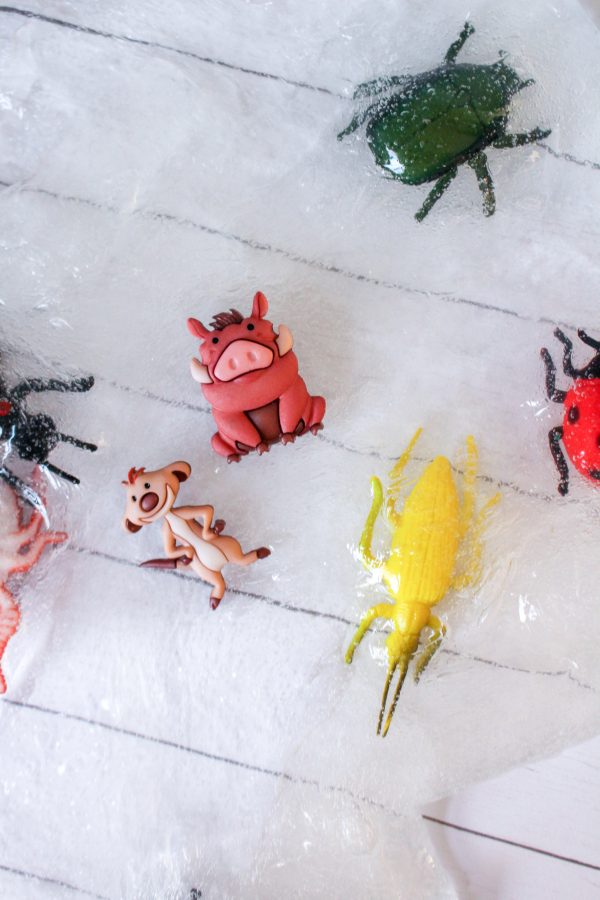
Supplies:
- 5 oz clear glue
- 1/2 cup water
- 1/2 tsp baking soda
- 1 tbsp contact solution
- Plastic Bugs
- Container
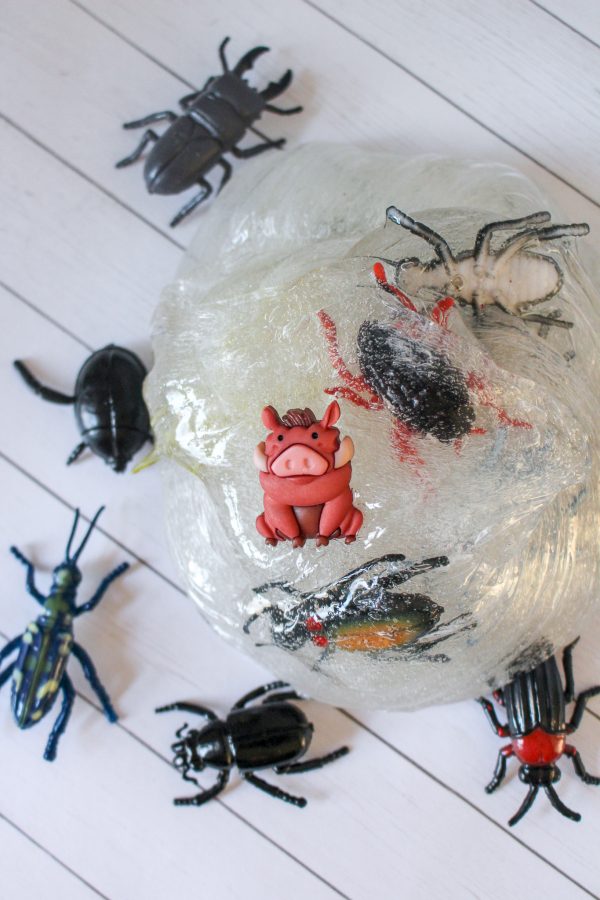
Instructions:
- In a bowl, pour 5 oz clear glue.
- Add 1/2 cup water. Mix until the glue has broken up and is incorporated into the water.
- Mix 1/2 cup baking soda in. Baking soda will help determine your slime thickness.
- Add 1 tbsp of contact solution. Mix. The slime will be ready to knead when it pulls away from the sides of the bowl. The contact solution is what makes the slime sticky or not.
- Knead the slime. It will be sticky at first, but keep kneading it! You can add a little contact solution if you have to, but be careful not to activate it.
- Once your slime has formed, you can add and knead your bugs.
- Store in an airtight container.
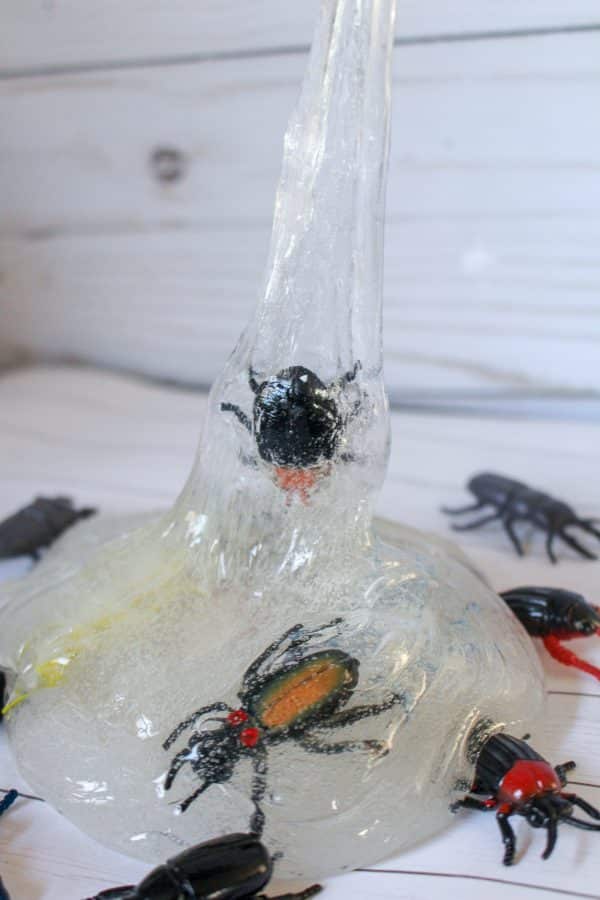
While it’s an excellent activity for kids of all ages, adult supervision is essential to ensure safety, especially for younger children, as this is not an edible slime recipe.
Table of Contents
What ingredients can I add to my bug slime to make it more unique?
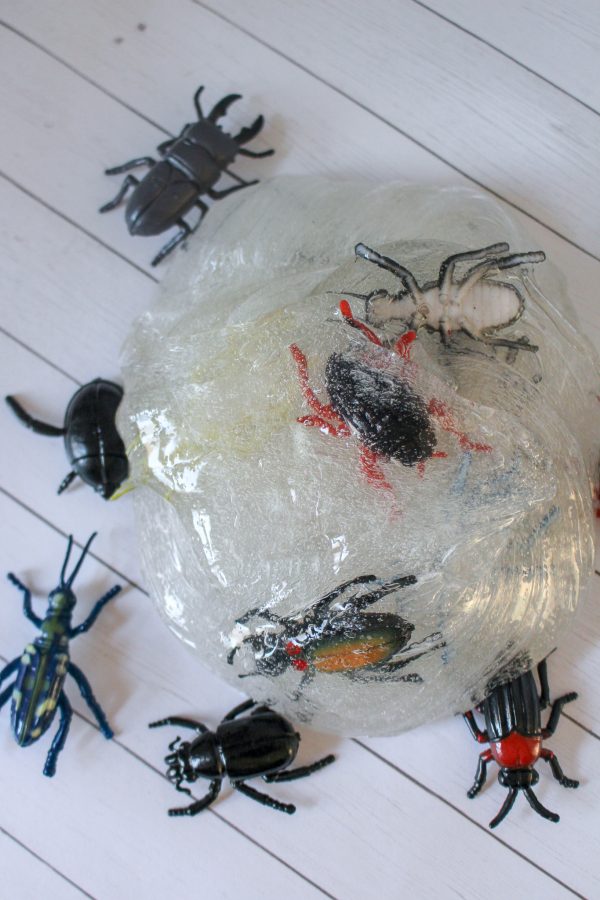
Wondering how to add a unique texture or color to your bug slime? Here are some great ideas:
- A few drops of food dye can transform your clear slime recipe into a vibrant goo. Red coloring, blue slime, or yellow food coloring can make it more eye-catching. Adding soap colorings is another great way to achieve the desired color.
- For a non-Newtonian fluid experience, turn your bug slime into bug slime oobleck by substituting cornstarch for baking soda. Cornstarch slime creates a unique texture that kids love.
- Gummy worms or plastic leaves can add extra fun and tactile engagement.
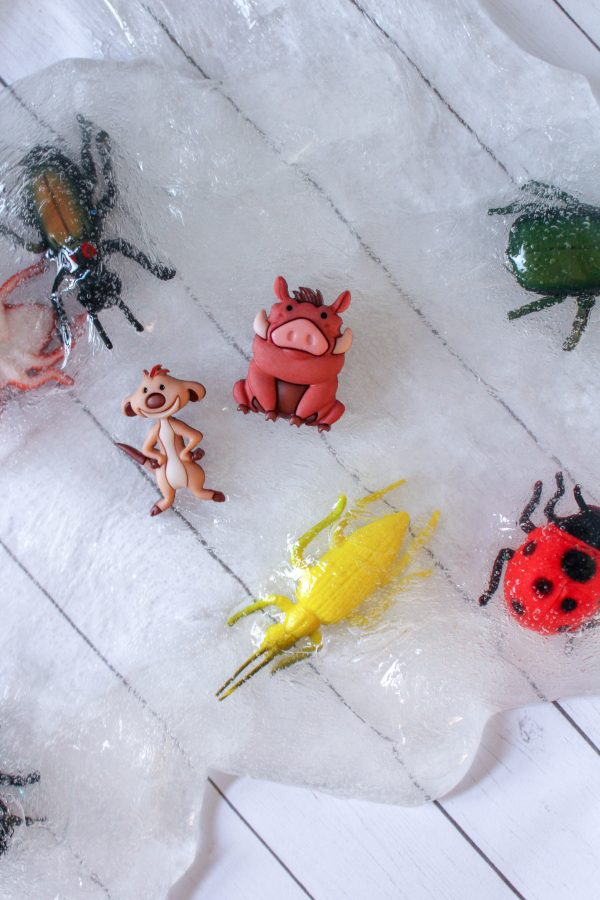
What makes this bug slime recipe unique?
This bug slime recipe is more than just a simple slime recipe. It’s a fun activity that keeps little hands busy and makes older kids curious. The bugs inside add a playful yet spooky touch, perfect for Halloween or bug-themed activities.
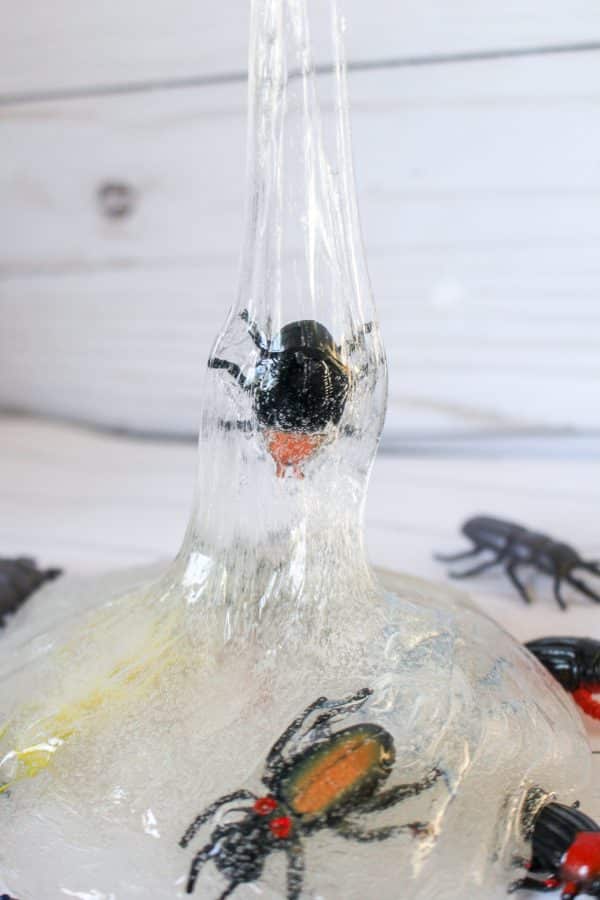
How can I make this activity educational?
Making slime can be a fun and educational activity. Here are some ways to make your bug slime activity educational:
Measurement and Math Skills
1. Counting and Measuring: Have kids measure the ingredients required for the slime. This helps them learn about measurements and improve their counting skills.
2. Fractions: Teach simple fractions by dividing the slime into halves, quarters, or other fractions.
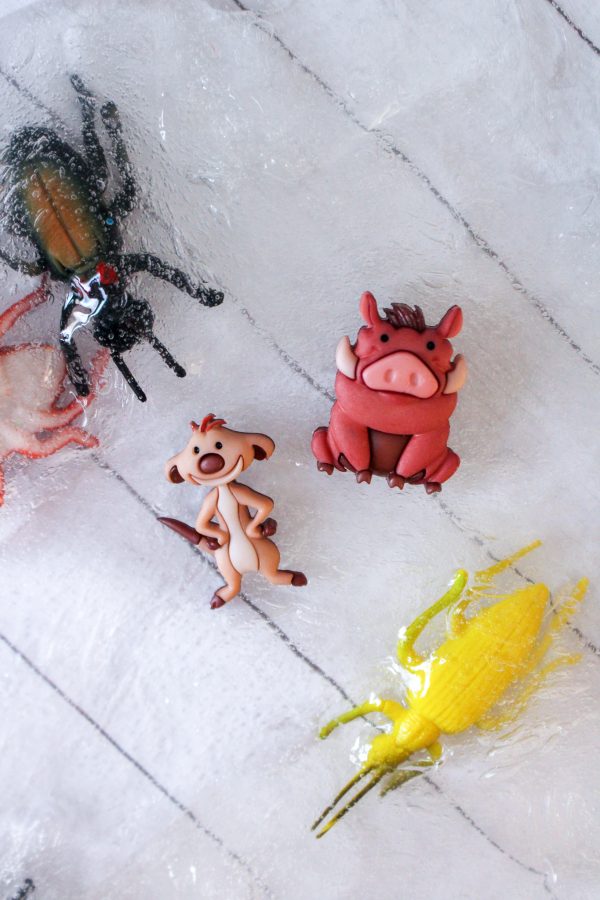
Science Exploration
1. Experiment with Textures: Change the slime’s texture by altering the amount of ingredients like baking soda or saline solution. Have the kids observe how the texture changes with different amounts of these ingredients.
2. Non-Newtonian Fluids: Explain that slime is a non-Newtonian fluid, which means it acts like a liquid when poured and a solid when a force acts upon it.
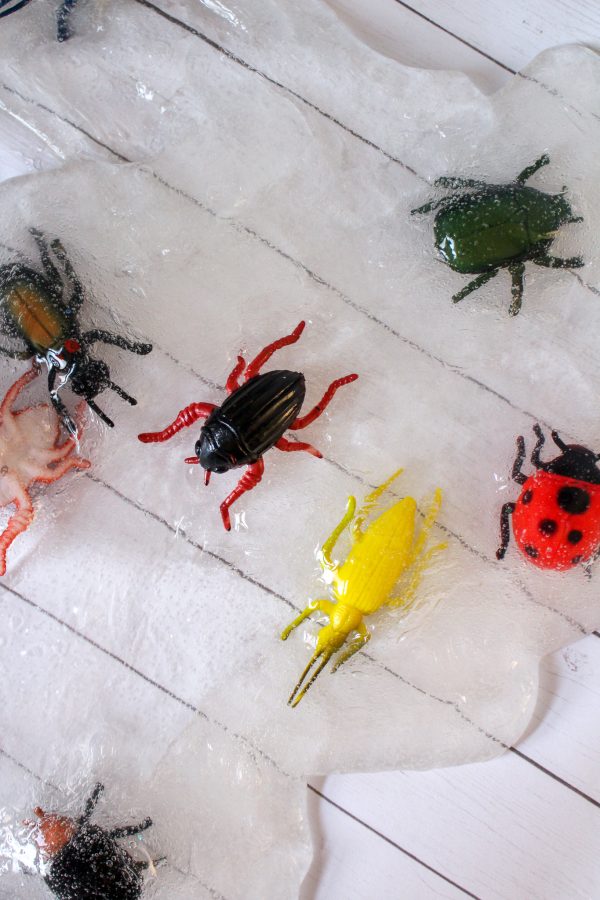
3. Polymer Chains: Explain how the glue (a polymer) interacts with the saline solution to form a new substance, slime, with different properties.
Sensory Play
1. Texture and Feel: Encourage the kids to describe the texture and feel of the slime, which helps them build vocabulary and understand textures.
2. Color Mixing: If you add food coloring, kids can learn about color mixing by observing how different colors blend to form new colors.
Diving into this bug slime activity is a fun way to spend the day and opens up a world of learning for kids. This simple slime recipe turns ordinary playtime into a chance to explore, discover, and learn.
It combines easy math, basic science, and playful exploration in a hands-on way. Crafting bug slime can make any day exciting and educational, whether it’s a sunny spring day or a spooky Halloween night. So, gather your supplies and get ready to have a slime-filled adventure!
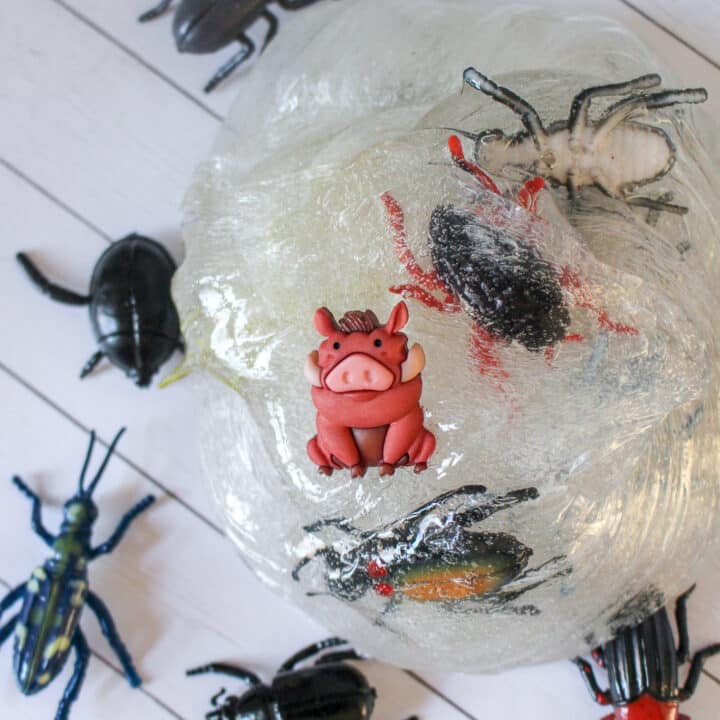
Easy Bug Slime
This bug slime recipe transcends the boundaries of a typical slime concoction; it's a captivating activity that entertains little hands and sparks curiosity in older kids.
Materials
- Clear glue
- Water
- Baking soda
- Contact solution
- Bug toys
Tools
- mixing bowl
Instructions
- Begin by selecting a bowl suitable for mixing your slime ingredients. Then, carefully pour 5 ounces of clear glue into the bowl.
- Next, add 1/2 cup of water to the clear glue bowl. This additional liquid will help create the desired slimy consistency. Mix the water and glue together thoroughly until the glue has broken up and fully incorporated into the water, resulting in a smooth and uniform mixture.
- Now, incorporate 1/2 cup of baking soda into the mixture. Baking soda is crucial in determining the thickness of your slime.
- It's time to add one tablespoon of contact solution to the mixture. As you mix in the contact solution, you'll notice the slime starting to come together and pull away from the sides of the bowl.
- Begin kneading the slime mixture with your hands. Initially, it may feel sticky, but don't worry—this is normal. Keep kneading the slime vigorously. The warmth of your hands and continued manipulation will help activate the ingredients and improve the slime's consistency.
- Once your slime has reached the desired consistency, it's time to add and knead your bug toys into the mixture. Gently incorporate the bug toys into the slime, distributing them evenly throughout.
- After incorporating the bug toys into your slime and enjoying some playtime, it is essential to store the slime properly to maintain its freshness and consistency. Transfer the slime to an airtight container.





This is fabulous. I love the addition of the bugs. More fun and more learning opportunities.